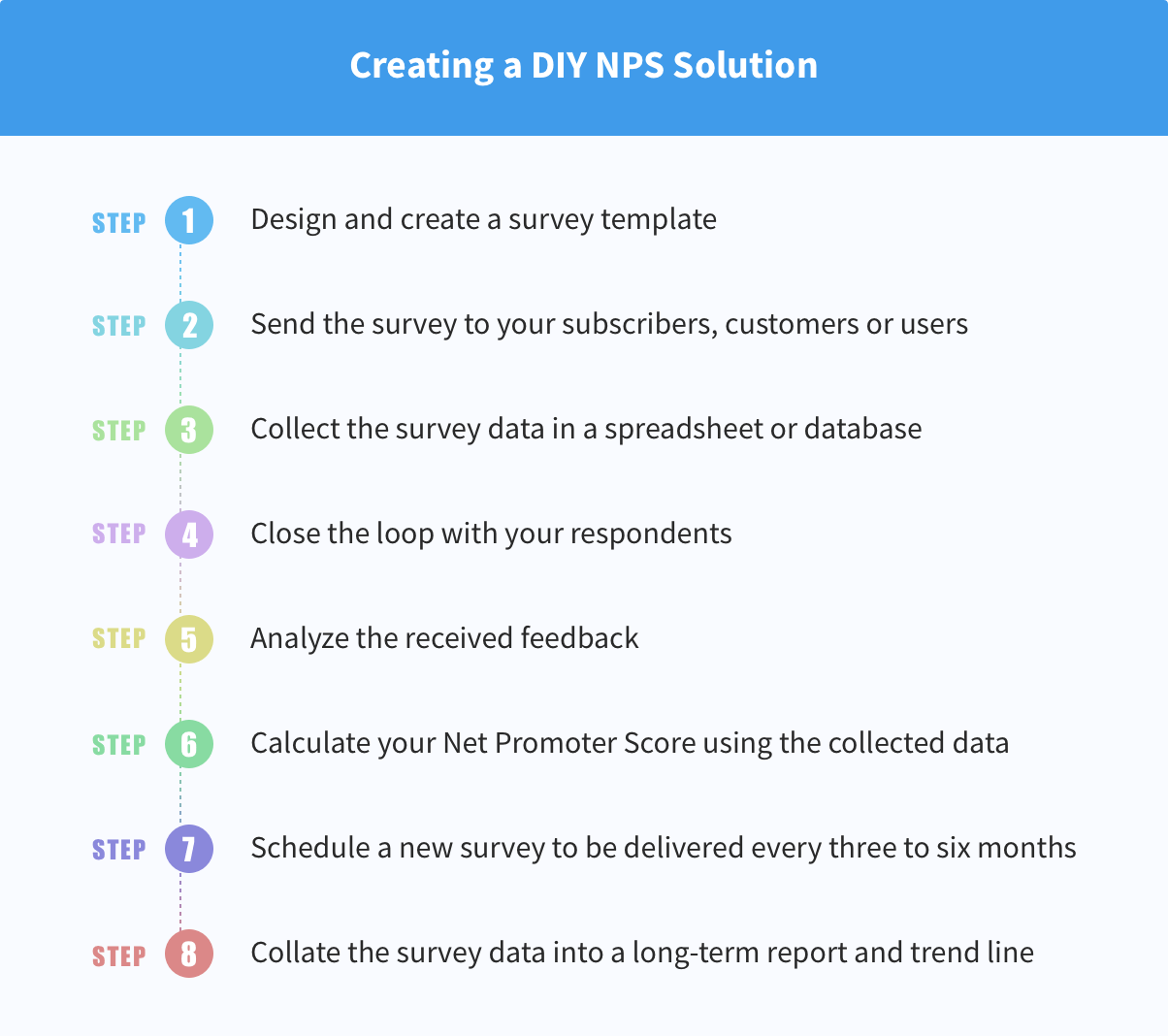One of the biggest strengths of Net Promoter Score® is its simplicity. Instead of asking customers endless questions, NPS® surveys are straightforward, addressing just one single question and allowing users to provide their own qualitative feedback.
This simplicity is part of what makes NPS so effective. A well-shaped NPS campaign can regularly achieve a response rate of 40% or more, compared to a paltry 3% average for a conventional marketing survey.
Since the mechanism behind NPS is so simple, we’re occasionally contacted by potential customers curious about the process of building a DIY Net Promoter Score system — an in-house system for sending out surveys, processing and calculating data, creating reports and viewing historical trends.
Essentially, why not create a DIY NPS platform instead of choosing a specialized NPS software?
Below, we’ve broken down the steps, services and processes required to turn an idea like this into reality, as well as our opinion on why it’s generally not worth it. Our conclusion is pretty simple: while doing this is possible, it’s definitely not worth the time (and money).
Creating Your Own NPS Solution
Before we get into the specifics of creating a do-it-yourself surveying solution, let’s look at the individual steps involved as per the below:
- Design and create a responsive survey template
- Send the survey to your subscribers, customers or users
- Collect the survey data in a spreadsheet or database
- Close the loop with your respondents
- Analyze the received feedback
- Calculate your Net Promoter Score using the collected data
- Schedule a new survey to be delivered every three to six months
- Collate the survey data into a long-term report and trend line

There’s also an extra step that doesn’t quite fit into the process above — sending out a custom notification to each survey response.
This is the most basic version of a functional NPS system. Adding extra features, such as being able to identify customer experience priorities and send surveys in multiple languages, would require additional effort and cost.
Even the bare minimum for an in-house Net Promoter Score is an eight-step process. Now, let’s break down each step into greater detail to find out if building a DIY NPS solution is worthwhile.
1. Designing and Creating a Survey Template
Of all eight steps involved in the in-house NPS process, this is the easiest. There are numerous survey builder applications available, ranging from free tools like Google Forms to a wide variety of paid survey tools such as Typeform.
Among these tools, Google Forms is the frugal option, but it comes with a downside — your forms will look a little unprofessional. It means you’ll need to pay $25+ every month for a paid tool if you’d like a professional design and the ability to export your survey results.
2. Sending the Survey to Your Respondents
For this particular step, you’ll need an email marketing service. While there are several free email marketing tools available, their free plans typically limit your reach to a few hundred users a month and add unwanted, unprofessional branding messages to your emails unless you upgrade to a paid plan.
You also need to be able to schedule survey emails several months ahead of time based on the way your users behave, meaning you’ll get more from a marketing automation platform than an ordinary email tool.
The approximate cost of this software? Assuming you have 2,500+ free trial users or customers at any one time, you can expect to pay $50+ per month for the email side of your DIY survey system alone. However, keep in mind that prices can vary significantly among different providers. The pandemic has caused shifts in market dynamics and customer behavior, leading to consistent adjustments in pricing strategies.
3. Collecting the Survey Data in a Spreadsheet or Database
Luckily, this part of the process is fairly simple. If you use Google Forms to send your in-house NPS survey, you can automatically export the data to a spreadsheet. Other survey software lets you export it as a CSV file or save it to various cloud-based storage systems.
Of all the steps in the process, this one is both simple and cheap. Once your data is stored in a spreadsheet, you have a variety of tools that you can use to view and analyze your customer feedback.
4. Closing the loop with your respondents
An easy way to close the feedback loop is to ask open-ended questions and explain how you plan to act on the valuable information your respondents share. This will confirm that you understand their point and will strive to provide the best customer experience. Also, you should let your customers know when the changes they’ve asked for will be implemented or solved.
Although you can mostly automate the feedback loop with Promoters, every Detractor and Passive response should be thoroughly analyzed and dealt with manually, over email, phone or during a planned quarterly business review session.
Tracking customer-reported issues and their resolution could be done by exporting the feedback into your task management service using Zapier.
5. Analyzing the received feedback
There is nothing more powerful than getting to see your brand through the eyes of your customers. However, when faced with lots of feedback, sorting through it becomes quite a challenge.
Digging into and manually processing all the received responses is a laborious task. Moreover, a manual analysis would imply multiple errors caused by a lack of consistent criteria and granularity. Customer feedback thus becomes time-consuming and expensive to analyze, interpret, and sort through.
The solution would be to use a text-analytics service like MonkeyLearn, which offers up to 300 queries per month for free, or create custom no-code integrations using Zapier/Make.com and OpenAI API. Additionally, consider the OpenAI Code Interpreter. It’s designed to automatically analyze data and provide powerful visualizations. If you want to learn how to use the tool to enrich your feedback, make sure to check this link.
The cost? Assuming your survey response rate is 10%, having 2,500 – 3,000 respondents can fit you into the free MonkeyLearn plan. Otherwise, expect to pay another $300+ per month.
6. Calculating Your Net Promoter Score Using Collected Data
This part of the process is also relatively simple. First, split your respondents into three groups — Promoters, Passives and Detractors — based on their survey rating. Then, subtract the percentage of Detractors from the percentage of Promoters.
In short, a few quick calculations can give you a working Net Promoter Score out of your survey data using a free NPS calculator.
7. Scheduling a New Survey to Be Delivered Every Three to Six Months
This is where things become a little tricky. Because measuring customer satisfaction using NPS is an ongoing process, you’ll need to resend your NPS survey every three to six months to keep track of changes and view long-term progress.
There are several ways to do this. If you use traditional email marketing software, you can send it out manually using an email broadcast. If you use marketing automation software, you can set up a scheduled email to go out exactly three months after the last completed NPS survey.
However, the issue with this approach is that you need to ensure the accurate recording of new responses alongside the old ones in your spreadsheet or database. Without this, you’ll be able to calculate your NPS, but not view and analyze trends on a per-customer level.
8. Collating the Survey Data Into a Long-Term Report and Trend Line
This is another relatively straightforward step, assuming you have access to a database or spreadsheet application. For spreadsheets, tracking your NPS is a simple process that you can complete by generating a line chart from your survey data.
If you store survey responses in a database, you’ll need to either create a custom system or use an existing code (once again, Google has a great feature) to turn your database entries into a visible trend line.
As for reporting, this is something you’ll need to do manually after reviewing the data from your survey and the charts it creates.
Features You’ll Be Missing
The process above will give you a simple, functional NPS system that lets you send surveys to your customers and calculate your NPS. However, it will be missing several major features that are available in specialized survey software:
- Without custom programming or Zapier, you won’t be able to send yourself automatic alerts when a customer gives a rating that classifies them as a Detractor or Passive, making it harder to reach out and convert them into a Promoter or enroll them into your customer advocacy program. It means there’s a much greater risk of dissatisfied customers canceling before you have a chance to reach out to them, or for you to lose on the deriving benefits as missing your Promoters’ referrals and reviews.
- While you can use an email delivering service, integrating your DIY survey into the email itself is a complex process that most email marketing software platforms do not support well. This means an extra clickthrough, which leads to a lower survey response rate.
- Even with the smartest marketing automation software, it’s very difficult to send custom follow-up messages to your customers based on their feedback when using a DIY solution for your NPS campaign.
- Closing the customer feedback loop, which is an essential part of NPS, becomes a much more complicated process that you’ll handle through your email inbox instead of a CRM or an all-in-one customer experience management platform. The result? More emails and a seriously cluttered inbox.
- Want to send a survey in a different language? To create a localized survey, you’ll need to hire a translator and have your existing survey text converted manually, costing your business time and money.
- Need to send a transactional NPS survey? Sending it using a DIY Net Promoter Score system means building a separate survey and creating a complex automation workflow in your email marketing tool — something that’s not a simple process.
- Instead of an engaging, user-friendly analytics dashboard that keeps all of your data in one place, you’ll need to manually create graphs and trend lines to stay on top of long-term progress and keep track of your Net Promoter Score.
- The most important part — you will be missing the insights offered by specialized software, such as a rating decrease from a former Promoter.
Additional Considerations
When deciding between DIY NPS and specialized NPS software, here are some further aspects to consider:
- Be aware that implementing a DIY NPS system can be time-consuming and resource-intensive. So, let’s start with a reality check. Ask yourself if your company has the financial means for such NPS initiatives without compromising other essential operations. Consider if you have enough staff to deal with the NPS-related workload – you need hands on deck for all of that! Besides, does your team have the necessary expertise, or will you need to provide training or bring in new talent? Can you handle this burden, especially if you’re a smaller business or have limited staff? Give that some thought.
- DIY NPS means you’re in the driver’s seat for data collection and analysis. That’s a good thing, but it’s only useful if your team has the skills and processes in place to maintain data accuracy. Keep in mind the possible risks of inconsistent survey design, data collection techniques, hence data quality without standard methodologies. What’s more, without an outside perspective, bias can affect data interpretation. So, can you be consistent and ensure objectivity throughout the process? Can your team make sense of the data and turn it into valuable insights?
- Think about your customers. Assess if your company can effectively handle a large volume of feedback and cater to different customer segments.
- If your business operates across multiple channels and platforms, assess the ability to collect comprehensive feedback at different touchpoints. Can you capture feedback at each and make it actionable?
- With great data comes great responsibility. Ensure your company is prepared to keep customer data safe and handle privacy concerns properly. So, are you equipped with the right policies and procedures to secure privacy?
- Evaluate if the DIY NPS can seamlessly integrate with CRM tools, analytics platforms, or other relevant systems. This cross-communication will give a more complete picture of your customer feedback.
- A successful NPS program needs long-term commitment. Weigh your business’ ability to devote the necessary resources to maintain the DIY NPS system and adapt it accordingly. Can you keep up with it, even when the market changes and customer expectations shift? On top of that, as your business grows, your NPS system will need to evolve. Consider the possible challenges in scaling a DIY NPS system. Can you manage them and do you have the expertise to adjust as needed?
- Acknowledge that DIY NPS systems may lack access to industry-related benchmarks. Just something to bear in mind when you’re trying to see where you stand.
So, is it Worth Creating a DIY NPS System?
In short, no. Creating an in-house NPS system using free tools like Google Docs, Google Forms, and Google Sheets will require a significant amount of time — by our estimate, anywhere from five to ten hours per month.
It also isn’t free. While you can create free forms and calculate your data using free software, you’ll need to pay for email marketing software to deliver your survey. Add automation into the equation and you’re looking at $50+ monthly for email delivery alone.
Then, if you want to create survey forms that look more professional than a Google Form, you’ll need to spend an extra $25+ for professional survey software.
Putting all processes together into an operational DIY surveying system would be possible with a free Zapier account; however, some additional features and integrations would add up from 20$ to 50$ per month for a premium subscription.
The total? For a bare-bones system, expect to pay at least $100 per month to manage your own Net Promoter Score surveying and analysis process in-house, in addition to the extra time involved in completing the numerous tasks listed above.
Another option would be to use SurveyMonkey, which gives some basic NPS templates and reporting, and might suffice if you want to send a one-time survey, instead of implementing NPS as an ongoing process in your business.
Manage NPS Campaigns Easily and Affordably with Retently
Retently is designed from the ground up to make surveying your customers, collecting feedback and working out your Net Promoter Score as easy as possible. It’s simple to use and covers every aspect of Net Promoter Score, from closing the feedback loop to winning back your Detractors.
Its seamless integration with other customer experience tools and platforms gives you a comprehensive view of the customer journey. And that’s not all – with a strong emphasis on CX, it offers features like customer segmentation and follow-up workflows, encouraging you to personalize interactions and address customer needs. You can count on Retently to keep your NPS efforts efficient, making it the right choice for those dedicated to nurturing strong customer relationships.
Want to try it out for yourself? Create your free trial account and start surveying your customers to get actionable feedback, real-time NPS data and insights on how to improve your business. Leverage the survey builder to create tailored CX survey questions for maximum impact.






























 Greg Raileanu
Greg Raileanu 

 Alex Bitca
Alex Bitca 



 Christina Sol
Christina Sol